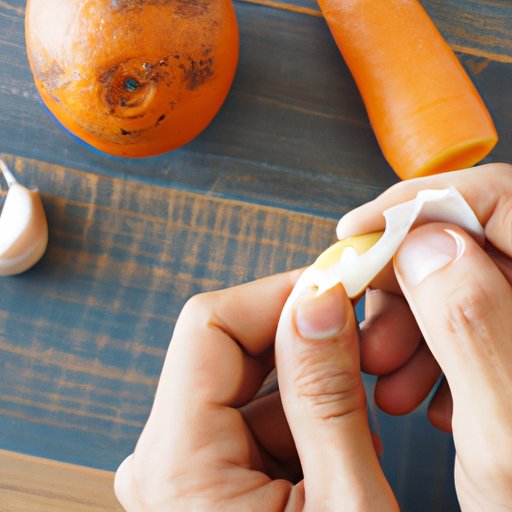
How to Fix a Jammed Finger: First Aid Techniques, Prevention, and Healing Foods
A jammed finger is a common injury experienced by athletes, workers, and regular people. It occurs when a finger is forcefully bent or twisted, leading to pain, swelling, and difficulty moving the affected finger. While it’s usually not a serious injury, it can be painful and impact daily activities. In this article, we will provide first aid techniques, preventative measures, professional help options, healing foods, coping strategies, and tailored advice to help readers fix their jammed fingers.
First Aid Techniques
It’s important to treat a jammed finger immediately after the injury to prevent further damage and promote healing. Here’s a step-by-step guide to treating a jammed finger at home:
- RICE (Rest, Ice, Compression, Elevation): Apply ice to the affected finger for 15-20 minutes every few hours to reduce inflammation and swelling. Rest and elevate the area as much as possible. Compression can also help reduce swelling.
- Finger exercises: Doing simple finger exercises, such as making a fist or opening and closing your hand, can help increase blood flow to the affected area.
- Splinting or taping the finger: Consider splinting or taping the finger to provide support and prevent further injury while it heals.
- Pain relievers: Consider taking over-the-counter medication to relieve pain and reduce swelling, such as acetaminophen or ibuprofen.
Preventative Measures
Preventing future finger injuries is crucial for maintaining healthy hands and fingers. Here are some tips and exercises to prevent jammed fingers:
- Proper technique when catching or throwing a ball: Avoid using your fingers to grasp the ball, and instead, use the palms of your hands to absorb the impact.
- Using the right tools for the job: Make sure to use the right equipment and tools for the job, such as wearing gloves when gardening or handling heavy objects.
- Warming up before physical activity: Take time to warm up before physical activity to help reduce the risk of injury.
- Strengthening finger muscles: Consider doing finger-strengthening exercises, such as squeezing a stress ball or using a hand grip strengthener.
Professional Help
If a jammed finger does not improve or shows signs of a serious injury, it’s important to seek medical attention to determine the extent of the injury. Here are some signs that indicate a finger injury is serious:
- The finger is deformed or discolored
- The finger is numb or tingling
- The finger cannot move
- The pain is severe and not improving
A doctor may prescribe a splint or cast, prescribe medication for pain relief, or recommend physical therapy to help with recovery. It’s important to follow the doctor’s advice and allow the finger to fully heal before resuming any physical activity.
Healing Foods
Eating a healthy diet with nutrient-rich foods can aid in the healing process of a jammed finger. Here are some tips for what to eat and what to avoid:
- Foods rich in vitamin C and protein: These foods can help speed up the healing process, such as lean meats, leafy greens, and citrus fruits.
- Foods to avoid that may slow down healing: Avoid processed foods, sugary drinks, and alcohol as they can slow down the healing process and cause inflammation.
Coping Strategies
Managing the pain and inconvenience of a jammed finger can be challenging but is essential for a full recovery. Here are some suggestions for coping with a jammed finger:
- Using heat or cold therapy: Apply heat or cold to the affected finger to help reduce inflammation and relieve pain.
- Taking time to rest: Take time to rest and avoid activities that can aggravate the injury.
- Using assistive devices: Consider using assistive devices such as a grip or splint to help with day-to-day activities.
Tailored Advice
Depending on your lifestyle or activity, you may require specific advice on how to prevent or treat a jammed finger. Here’s some tailored advice for groups such as athletes, musicians, and desk workers:
- Athletes: Consider using sport-specific gloves or tape to help protect your fingers during physical activity and warm up properly before any physical activity.
- Musicians: Pay attention to your technique and consider using ergonomic instruments or wrist braces to help avoid injury.
- Desk workers: Consider using an ergonomic keyboard or mouse and take frequent breaks to stretch your fingers and hands.
Conclusion
In conclusion, a jammed finger may seem like a minor injury, but it can impact daily activities and require proper treatment to fully heal. Remember to follow first aid techniques, prevent future injuries with proper safety measures, seek professional help if necessary, eat a healthy diet, use coping strategies, and receive tailored advice for your specific lifestyle and activity.
If you experience severe or ongoing pain, it’s important to seek medical attention to ensure proper diagnosis and treatment. Take care of your fingers and hands to maintain a happy and healthy life.




